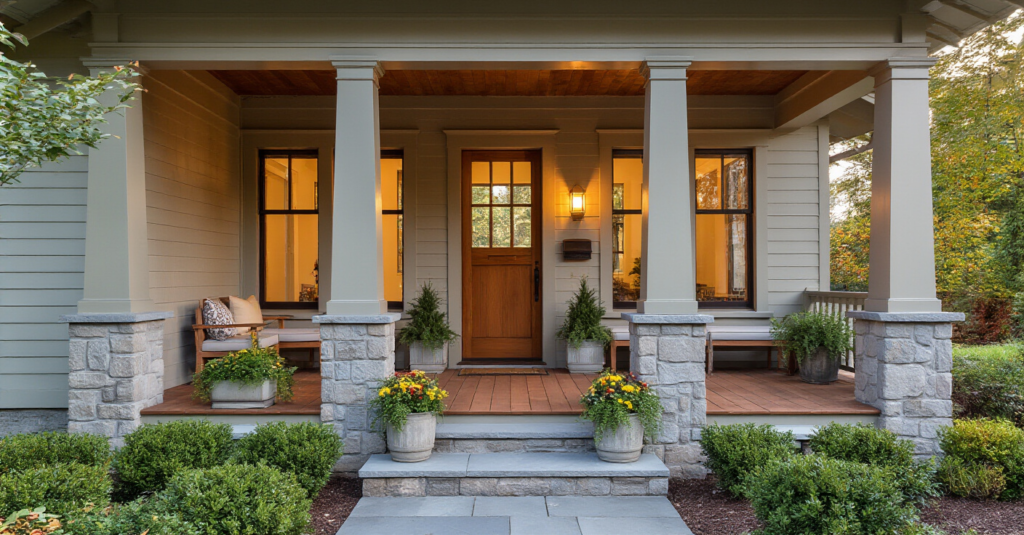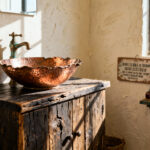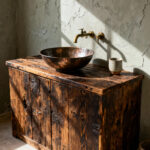I was walking up to a new client’s house last week, a gorgeous 1890s Queen Anne with a turret and intricate spindlework, and I had to stop in my tracks. There, on that magnificent porch, sat a pair of neon green plastic Adirondack chairs. It was like seeing a classic novel with a cheap, cartoonish cover. Nothing makes you consider the dialogue between a house and its owner quite like a moment of such profound architectural dissonance. That feeling of sudden disharmony—when you see an object so completely at odds with its surroundings—is exactly what separates intentional stewardship from accidental accumulation.
Your historic home’s front porch isn’t just a blank slate for the latest trends. It’s the opening chapter to a story that began long before you arrived. It has its own voice, its own character, baked right into the columns, the railings, and the floorboards. Our job isn’t to shout over it with decorations that will be out of style next year; it’s to listen to what the house is telling us and add our own respectful verse. Forget the disposable, big-box-store noise. I’m going to show you how to make your porch an authentic, beautiful, and functional extension of your home’s unique history.
Planning Your Porch’s Welcoming Vibe (Part 1)
Before you buy a single planter or pillow, you have to do the foundational work. This is the part everyone wants to skip, and it’s why so many historic porches end up feeling… off. We’re not just throwing furniture on a slab of concrete; we’re collaborating with the original architect and craftspeople. This is about understanding the grammar of your home so that the words you add—the furniture, the lighting, the colors—make a coherent and beautiful sentence.
1. Assess Your Porch’s Layout and Architectural Style
Can we talk about why so many people get this wrong? They measure for a new sofa but they don’t bother to “read” their own house. Before you do anything else, you have to understand the architectural language your home is speaking. Is it a symmetrical Colonial Revival that demands balance and formality? Or a rambling, asymmetrical Victorian that loves intricate detail? Is it a sturdy, honest Arts and Crafts bungalow that values handcrafted quality over frills? The bones of the house give you your entire design brief.
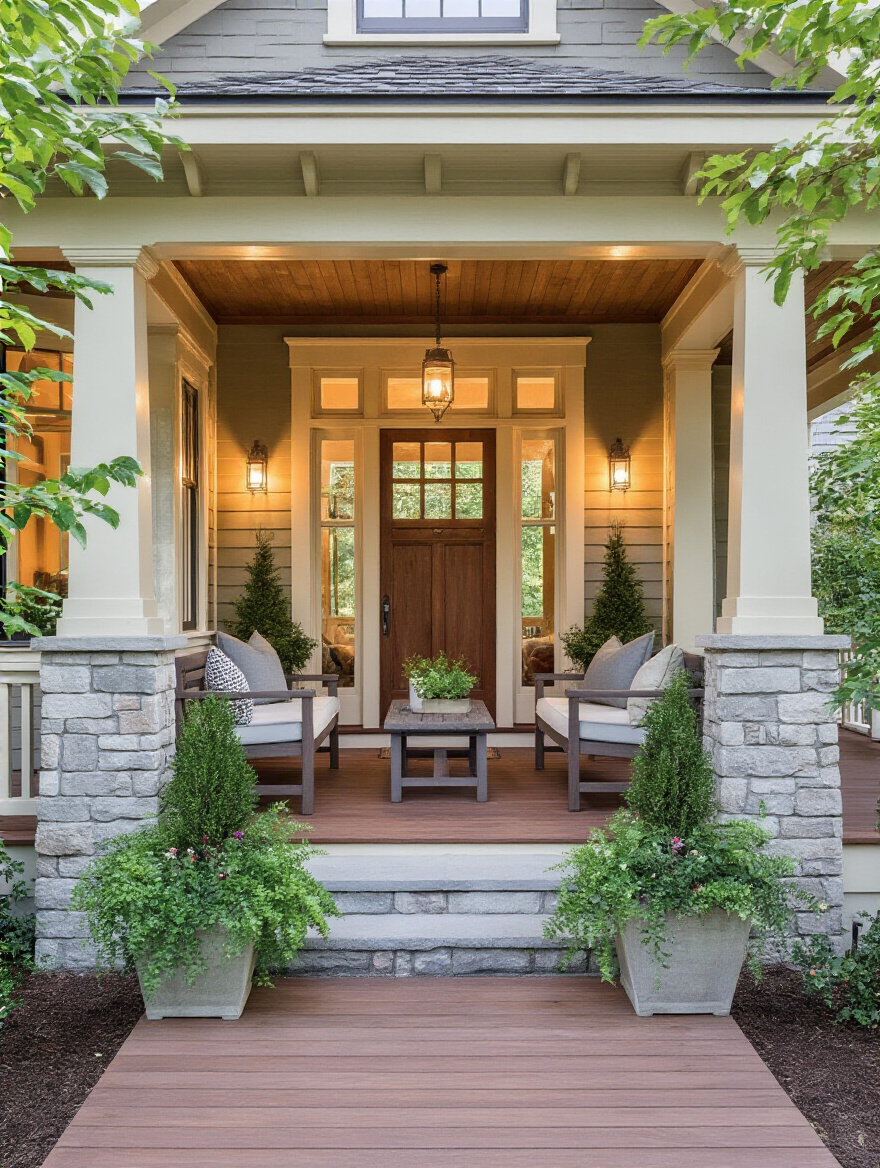
I once worked with a client who owned a beautiful, stern Greek Revival. She wanted a whimsical, cottage-style porch with overflowing, mismatched planters and a brightly painted porch swing hung off to one side. I had to gently explain that her house, with its rigid columns and formal symmetry, would be fighting that look every step of the way. It would look less like intentional design and more like a mistake. Instead, we leaned into its character with two large, classic urns flanking the door and a stately black bench—honoring the house, not fighting it.
With the architectural language in mind, the practical considerations of layout become much clearer. Where you place that bench or those planters suddenly has a purpose beyond just filling space.
2. Define Your Desired Front Porch Theme and Color Palette
Here’s the secret: you don’t need to invent a theme. Your house already has one. Your job is to uncover it and amplify it, not to impose a “Modern Farmhouse” or “Coastal Chic” theme onto a home that has no business being either. The biggest BS in home decor today is the idea that any style can be slapped onto any structure. An authentic home feels cohesive, and that starts by drawing your color palette and decorative motifs from the home’s own history.
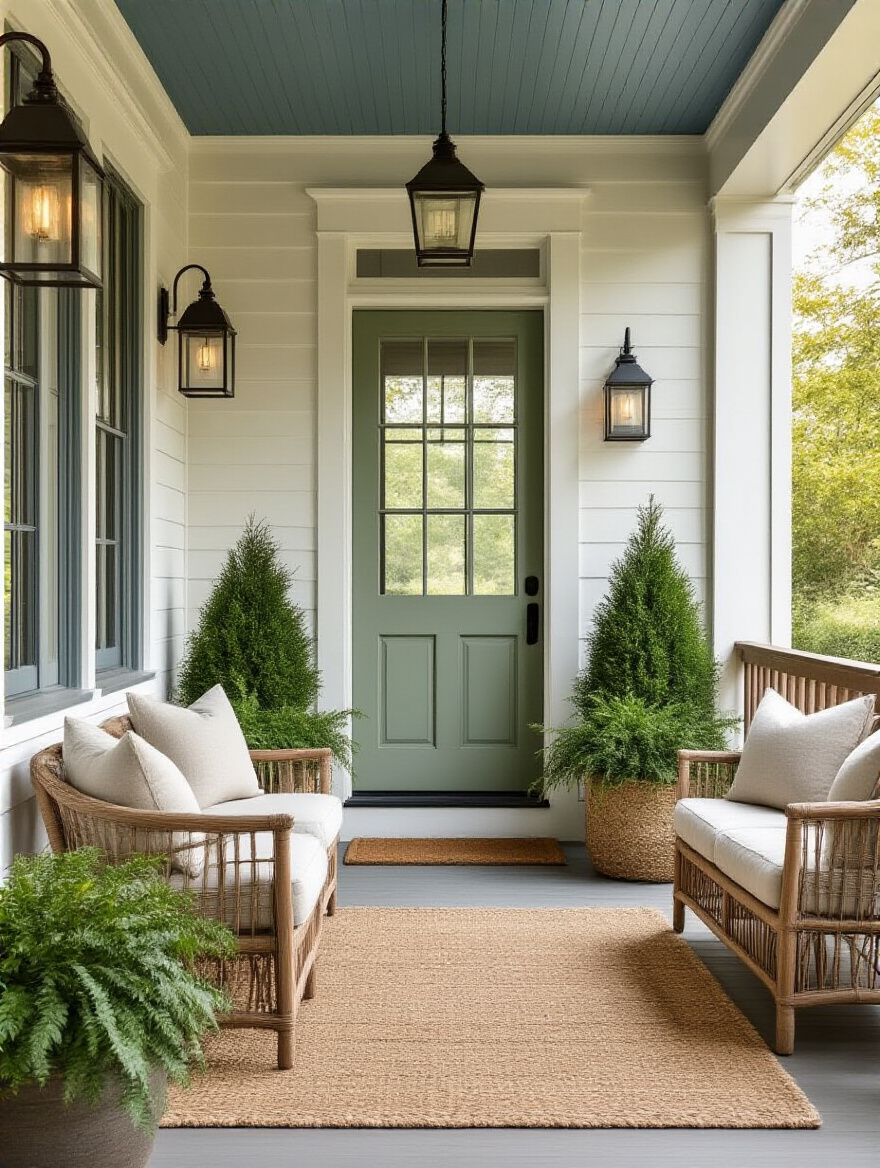
Look for inspiration in historical paint palettes. Companies like Sherwin-Williams and Benjamin Moore have fantastic historic collections that take the guesswork out of it. A Victorian, for instance, can handle a complex, multi-color scheme of deep greens, rich burgundies, and ochre—it was meant to be a “painted lady.” A Craftsman bungalow, on the other hand, calls for earthy tones that connect it to the landscape: mossy greens, warm browns, and stony grays. Let the architecture be your guide, and the result will feel timeless, not trendy.
Once you have a historically informed palette, every other choice becomes simpler, creating a harmony that no Pinterest trend can replicate. Next, we’ll ground this vision in financial reality.
3. Establish a Realistic Budget for Decor Investments
Everyone thinks a budget is about limitation, but for a historic home, it’s about priorities. It’s the tool that keeps you from wasting money on disposable junk and helps you invest in things with permanence and integrity. You’re far better off buying one perfectly-crafted, historically-appropriate cast iron bench that will last for 50 years than a dozen cheap cushions and signs you’ll throw away next season.
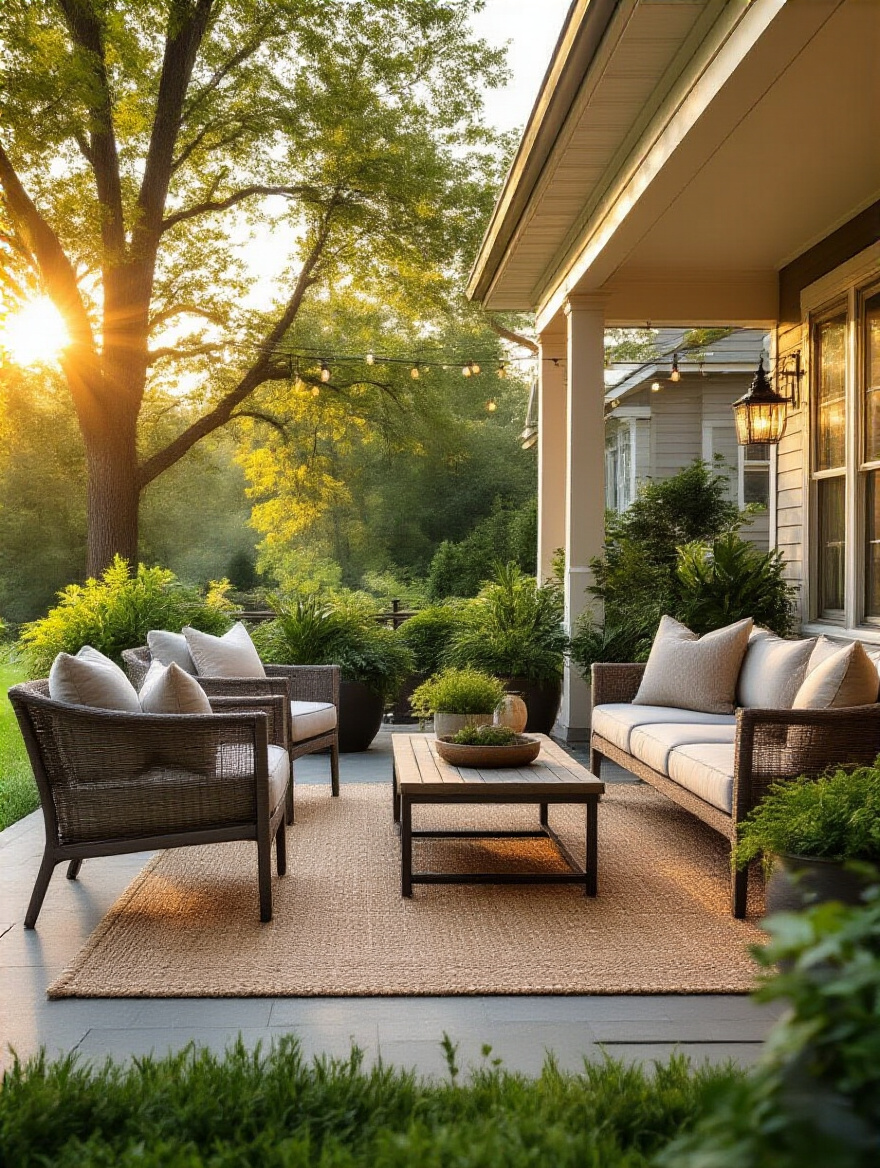
I used to think you needed a massive budget for these projects. Then I started exploring estate sales, antique shops, and architectural salvage yards. That’s where the real treasures are. A client with a modest budget for her 1920s Tudor found a set of stunning, heavy iron lanterns at a salvage yard for a quarter of what cheap reproductions would have cost. They had real patina, real history. So, budget for quality over quantity. Allocate funds for the permanent pieces first—seating, lighting, substantial planters. The fleeting things, like seasonal plants, can be managed year to year.
This approach of prioritizing enduring quality naturally leads to considering how each piece, big or small, fits into the overall composition.
4. Consider Scale and Proportion for Balanced Visuals
Have you ever seen a massive, overstuffed sofa on a tiny porch? Or a teeny-tiny welcome mat in front of a grand eight-foot door? It creates a visual tension that’s deeply unsettling. Scale and proportion are the unsung heroes of good design. The goal is for every element on your porch to be in a comfortable conversation with the house itself. Your home’s facade is the main character; the porch decor pieces are the supporting cast. They shouldn’t be trying to steal the show.
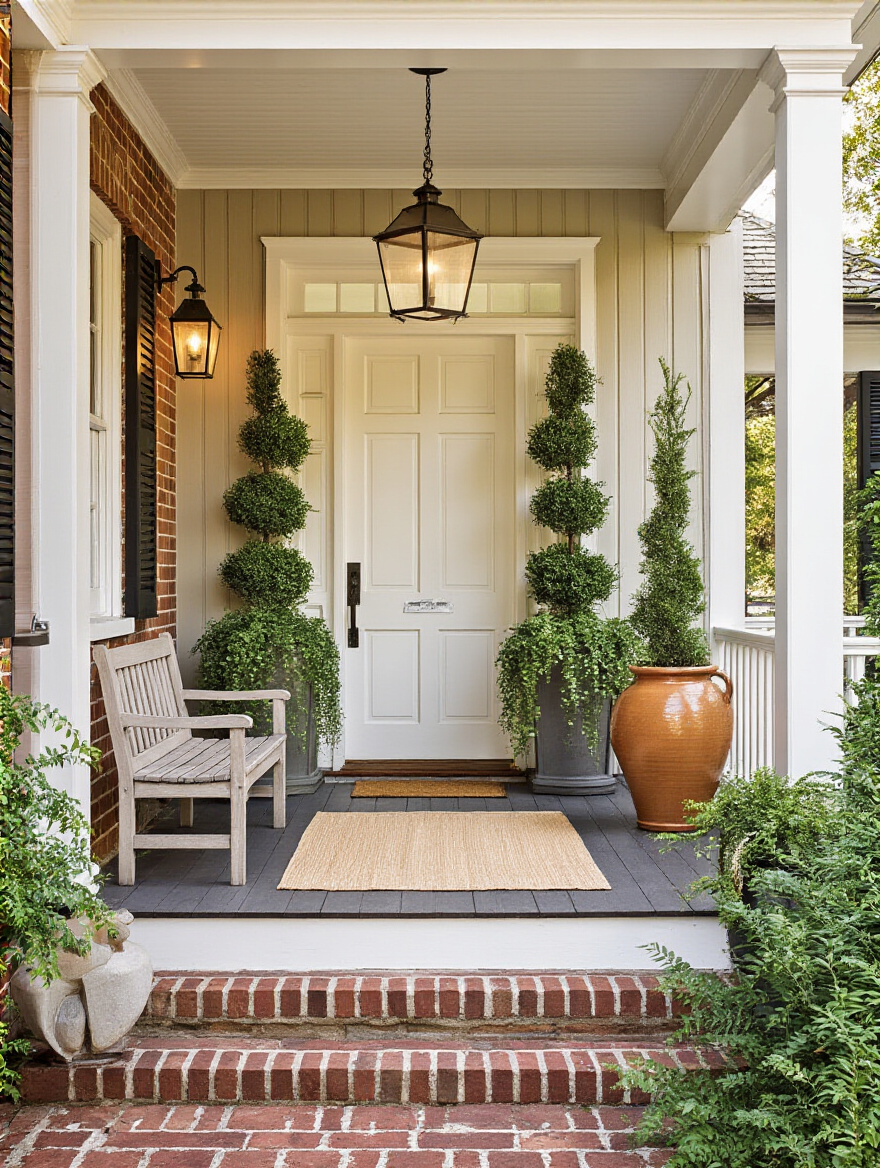
For grand Colonial or Victorian porches, you need furniture with substance. Think large wicker sets or heavy wooden rockers that can hold their own against the scale of the house. For a smaller bungalow porch, slender benches or a pair of more modest-sized chairs are a better fit. Always consider the vertical space, too. A home with tall columns or a high roofline can handle tall planters or hanging ferns that draw the eye upward, celebrating its height rather than letting it go to waste. A pro tip is to use painter’s tape to mark out the footprint of furniture on your porch before you buy it—it’s a simple trick to avoid a costly, oversized mistake.
Getting the scale right is a huge part of making a porch functional, which is exactly where we need to focus next.
Planning Your Porch’s Welcoming Vibe (Part 2)
We’ve laid the intellectual groundwork. Now, let’s get practical. A beautiful porch that doesn’t work for real life is nothing more than a museum piece. The true art of a historic renovation is blending that timeless character with the needs of modern living. Your porch should guide people to your door effortlessly and invite them to stay, not create an obstacle course of beautifully-proportioned decor.
5. Plan for Functionality and Foot Traffic Flow
People always ask me what the single biggest mistake in porch design is, and it’s this: forgetting that people actually have to use it. They’ll create a gorgeous seating area that completely blocks the path to the front door, forcing guests to awkwardly sidle past. A porch has one primary job: to provide a clear and welcoming path to the entrance. Everything else is secondary.
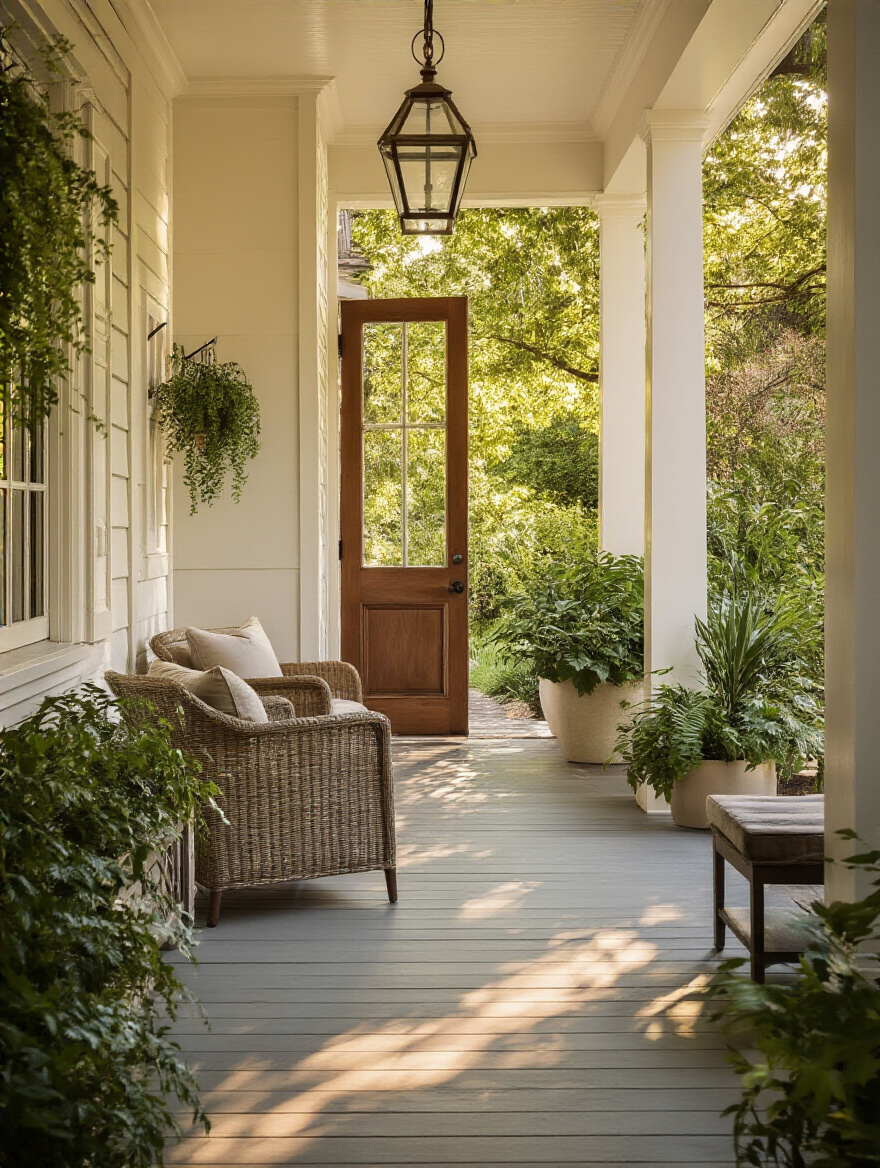
Before you place a single object, walk the path from the sidewalk or driveway to your front door. That line of travel must remain unobstructed, ideally with at least 36 inches of clear space. Then, you can designate zones around that path. Maybe you have a corner perfect for a small seating vignette, or a space beside the door for package deliveries. By defining these zones, you ensure that beauty doesn’t get in the way of function. The best designs feel effortless, and that only happens when you’ve thought through how the space will be moved through.
Once you’ve established a clear path for guests to walk, you need to give them a proper place to wipe their feet.
Crafting Your Core Porch Experience (Part 1)
Now we get to the good stuff—the core elements that transform your porch from an architectural feature into a living space. These are the foundational pieces that set the tone for the entire experience. Think of it as setting the stage. You need the main set pieces in place before you can start adding the smaller, more personal props. We’ll start from the ground up.
6. Choose a Durable and Eye-Catching Welcome Mat
Let’s be honest, most welcome mats are a sad, flimsy afterthought. But for a historic home, even this small detail is an opportunity to reinforce character. Your welcome mat is the very first physical interaction a guest has with your home, and it should feel substantial and appropriate. Ditch the cutesy sayings and flimsy synthetic rugs that disintegrate after one season.
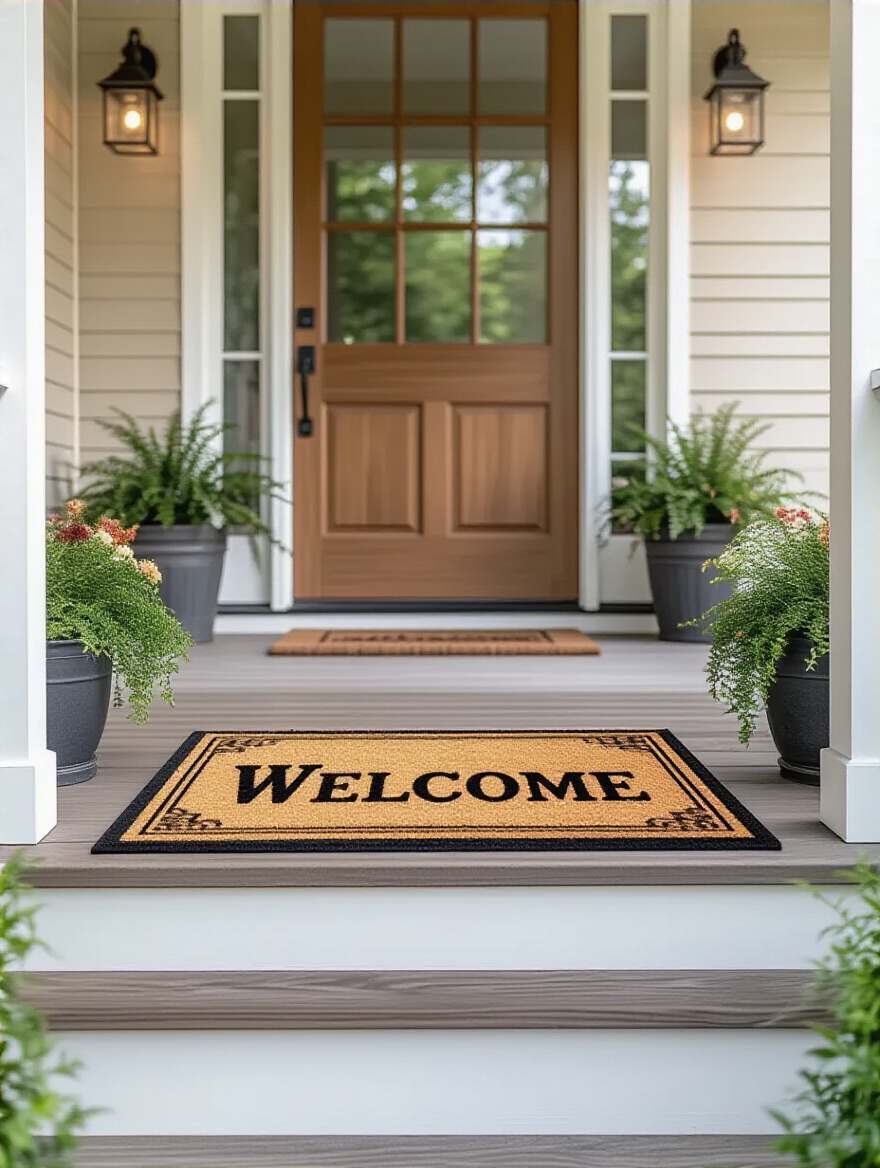
Look for mats made from natural coir (coconut fiber), which is incredibly durable and effective at scraping shoes. For a more formal look, a heavy-duty cast iron grate mat is period-perfect for Victorian and Second Empire homes. I love layering a durable coir mat on top of a larger, simple outdoor rug in a natural fiber like jute. It adds a level of texture and intention that signals from the first step that this is a home where details matter.
After welcoming guests with a proper mat, the next step is to invite them to stay awhile with comfortable seating.
7. Select Comfortable, Weather-Resistant Seating Solutions
The idea that you have to sacrifice historical accuracy for comfort is complete nonsense. The key is to select seating that complements your home’s architectural era and is made from materials that can withstand the elements. For a rambling Victorian porch, nothing looks better than white wicker furniture—just opt for the modern, high-quality resin wicker that looks identical but lasts for decades. A classic porch swing is almost mandatory for a Craftsman bungalow, evoking that era’s emphasis on leisure and connection to the outdoors.

Don’t fall for the trap of using indoor furniture outside. I’ve seen it a hundred times, and it never ends well. Wood will rot, fabric will mildew. Invest in pieces made from teak, which weathers to a beautiful silver, or powder-coated aluminum and wrought iron. And for cushions, Sunbrella fabric is the undisputed champion. It resists fading, water, and mildew. Spending a bit more upfront on the right materials will save you from the headache and expense of replacing everything every few years.
With a place to sit secured, it’s time to bring in the element that truly makes any space feel alive.
8. Introduce Lush Greenery with Strategic Planters
Nothing softens the hard lines of architecture like living plants. But please, I’m begging you, skip the cheap plastic pots. The vessel is just as important as the plant itself. A historic home deserves planters with gravitas and authenticity. Look for classic materials like terracotta, cast iron urns, glazed ceramic, or simple wooden planter boxes that you could imagine having been there for a hundred years.
The “thriller, filler, spiller” formula is a classic for a reason. For a formal look, create symmetry with two identical planters flanking the front door, each with a tall, structural plant (the thriller), like a boxwood topiary. For a more relaxed Arts and Crafts feel, group pots of varying sizes with a mix of ferns, flowers, and trailing ivy. I always advise clients to consider foliage as much as flowers. The varied textures and shades of green from plants like coleus, hostas, and ferns can provide interest long after the blooms have faded.
Greenery is essential for daytime charm, but as the sun sets, a different element becomes critical for creating that welcoming glow.
9. Install Inviting and Adequate Lighting Fixtures
Lighting is where so many people default to the cheapest, most generic fixture they can find at a big-box store. This is a huge missed opportunity. The right lighting is functional security, but it’s also powerful mood-setting jewelry for your home’s exterior. Your light fixtures should look like they belong to the era of your home, even if they’re modern reproductions with energy-efficient bulbs.
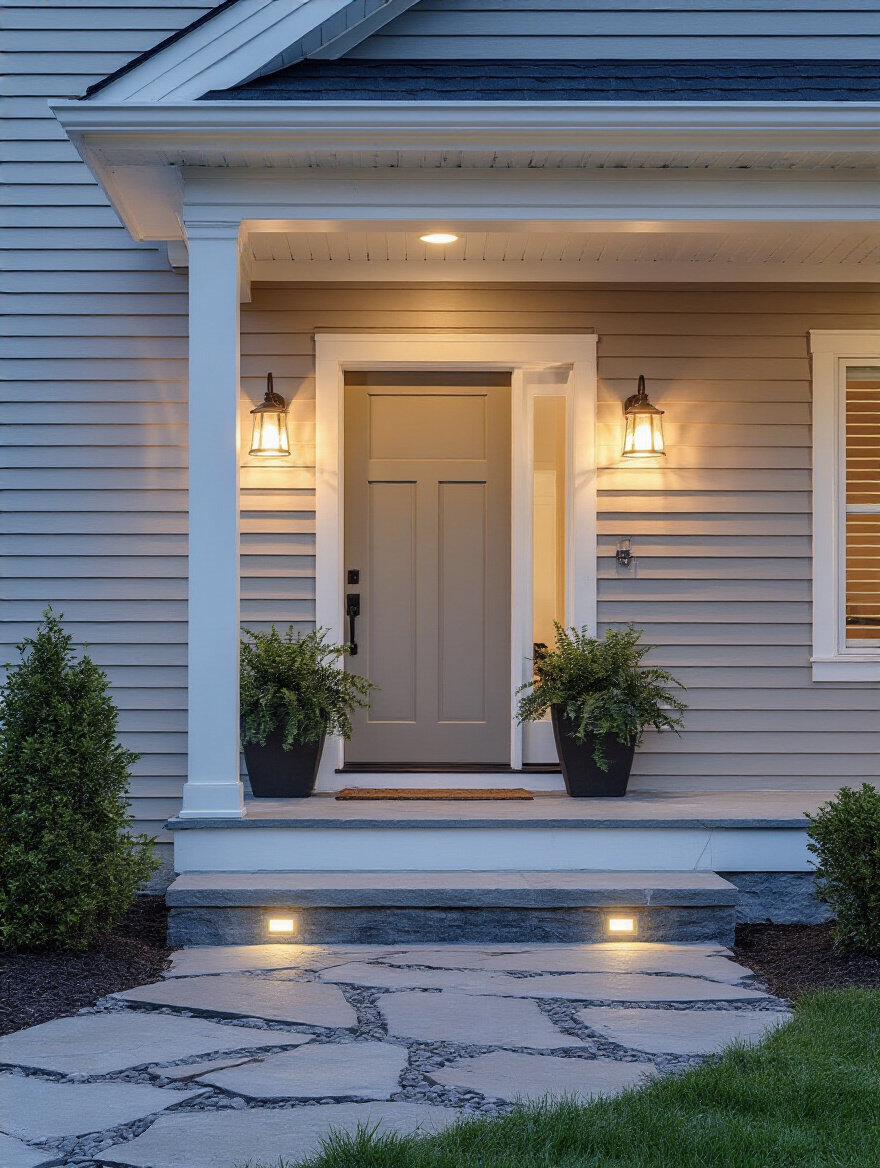
For a Craftsman home, look for fixtures with straight lines, amber glass, and a dark bronze or iron finish. A Colonial Revival calls for lantern-style sconces, often with brass or black finishes. For Victorians, more ornate, gas-lamp-style fixtures are perfect. And please, use warm-temperature bulbs (around 2700K). The harsh, blue-white light of high-kelvin LEDs can make even the most beautiful historic home feel cold and sterile. One fixture is rarely enough; layering wall sconces with overhead pendants or even subtle step lighting creates a much more sophisticated and welcoming effect.
With the core structural and living elements in place, we can now turn to the details that broadcast your home’s unique personality.
Crafting Your Core Porch Experience (Part 2)
We’ve covered the foundational “bones” of the porch—the seating, the plants, the lighting. Now we add the layers that make it feel curated and personal. These are the elements that move the needle from “well-decorated” to “truly special.” This is about adding your signature to the home’s ongoing story, starting right at the front door.
10. Curate Meaningful Wall Decor or Door Accents
Your front door is the focal point of the entire facade, so it deserves to be dressed with care. Forget the generic, mass-produced “Welcome” signs. Instead, think about accents that have character and substance. A beautiful, heavy brass door knocker in a style appropriate to your home’s era—like a lion’s head for a Georgian or a more intricate design for a Victorian—adds instant dignity.
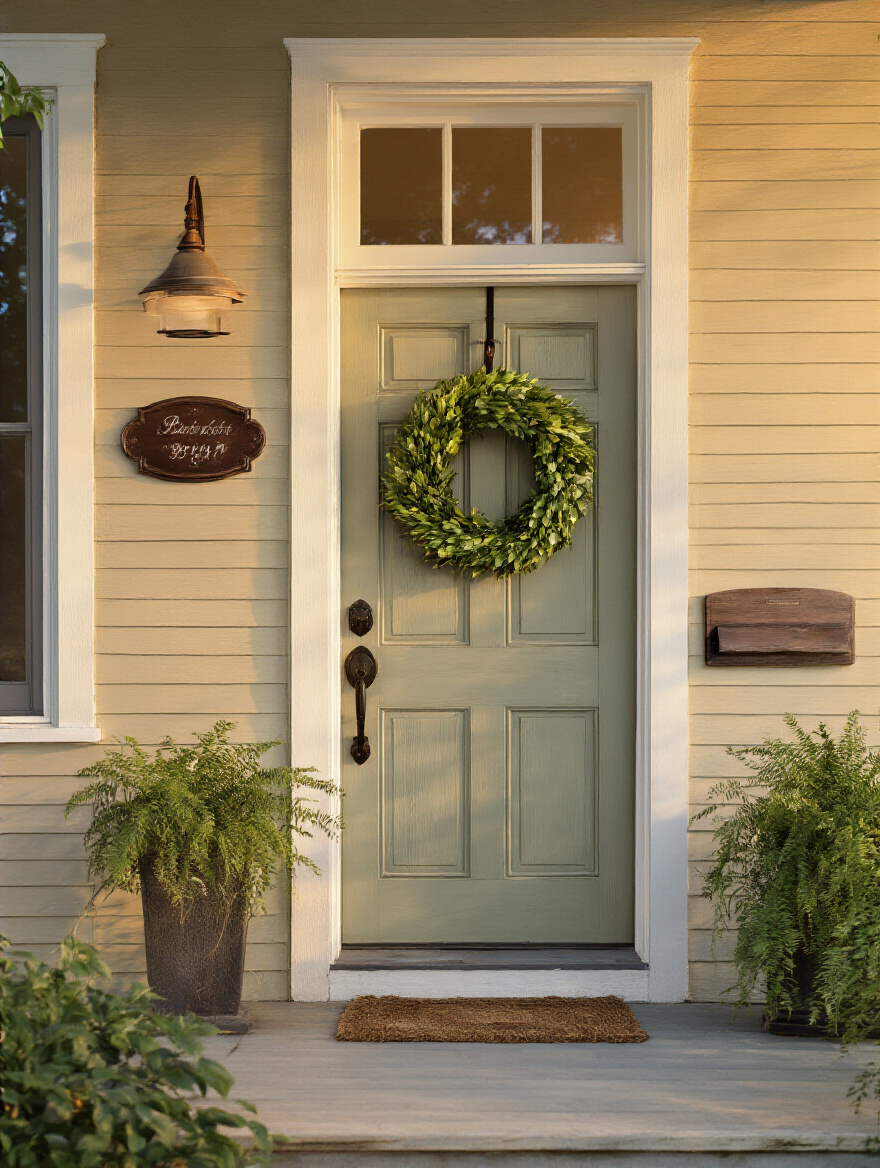
Custom, high-quality house numbers are another fantastic investment. Look for fonts and materials that match your home’s style. For a Craftsman, you can find beautiful ceramic tiles in the classic Gamble House font. For a mid-century home, sleek, brushed nickel numbers are perfect. A simple, elegant wreath made from natural, seasonal materials is always a better choice than a plastic one. It’s about choosing one or two high-quality accents rather than cluttering the space with a dozen flimsy ones.
These hard accents are important, but for a truly inviting porch, you need to introduce some softness and comfort.
11. Add Cohesive Throws and Outdoor Cushions for Comfort
This is where you transform your porch from a place you pass through into a place you live. The right textiles—pillows and throw blankets—are the final layer of comfort that makes seating truly inviting. But just like with furniture, you cannot cheat with indoor materials. They will be a mildewed, faded mess in a matter of weeks. It’s a waste of money and it looks terrible.
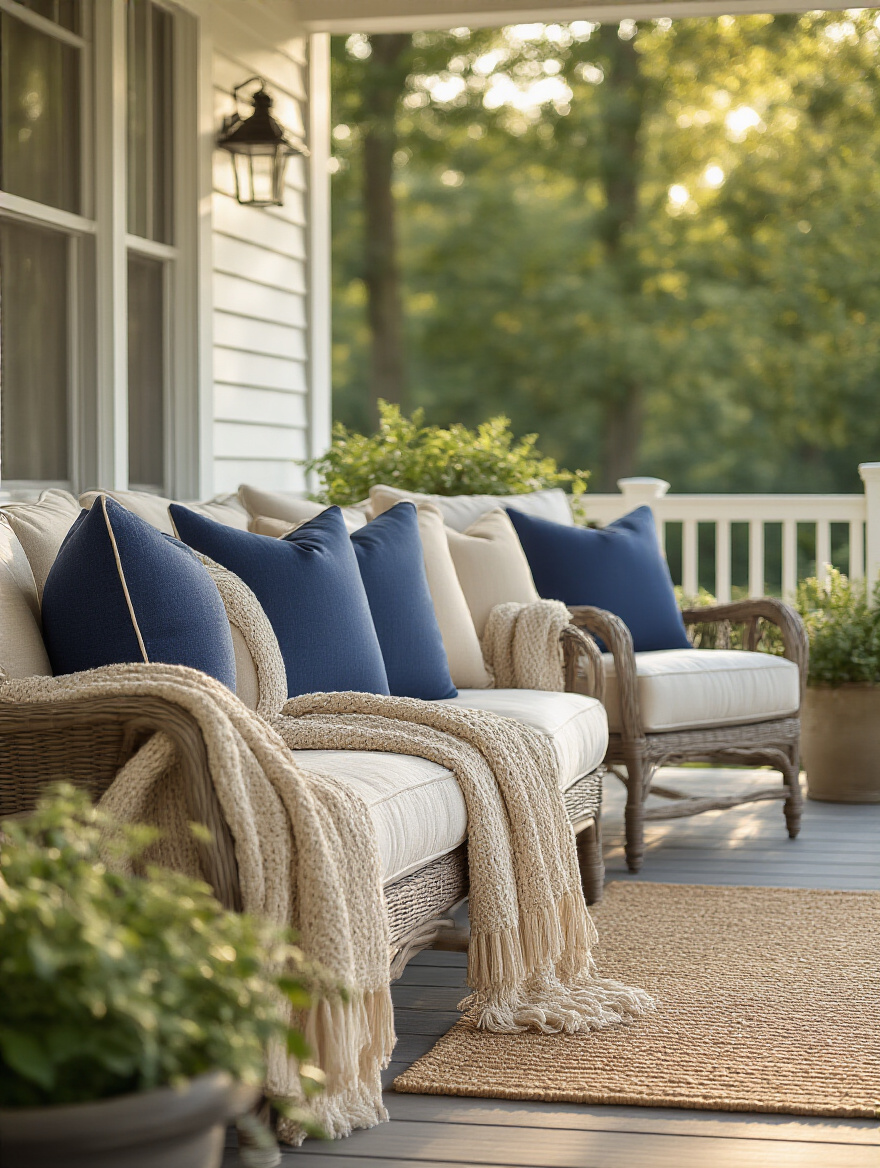
Invest in pillows and cushions made with genuine outdoor fabrics and quick-dry foam inserts. Again, Sunbrella is the industry standard for a reason. Don’t go overboard with patterns. Choose a cohesive color palette drawn from your home’s exterior and stick to it. I love using a mix of solids and a simple, classic pattern like a stripe or a subtle geometric that feels appropriate to the home’s period. A cozy throw draped over a chair not only adds a pop of color and texture but also genuinely encourages you to come out on a cool evening.
Now that we have the core experience dialed in, let’s explore the smaller, decorative touches that add depth and personality.
Elevating Your Porch with Decorative Accents (Part 1)
This is the styling phase, where we add the final touches that make the porch feel thoughtfully curated and lived-in. We’ve built the foundation and added the comfortable core; now we bring in the accessories. These smaller elements are what will give your porch its unique character and charm, starting with some highly functional surfaces.
12. Incorporate Functional and Stylish Side Tables
What good is a comfortable chair if there’s nowhere to set your glass of iced tea or a good book? A side table is a non-negotiable piece of functional decor. It completes a seating area, making it genuinely usable. Just like everything else, the style and material should feel cohesive with the rest of your porch and the architecture of your home.
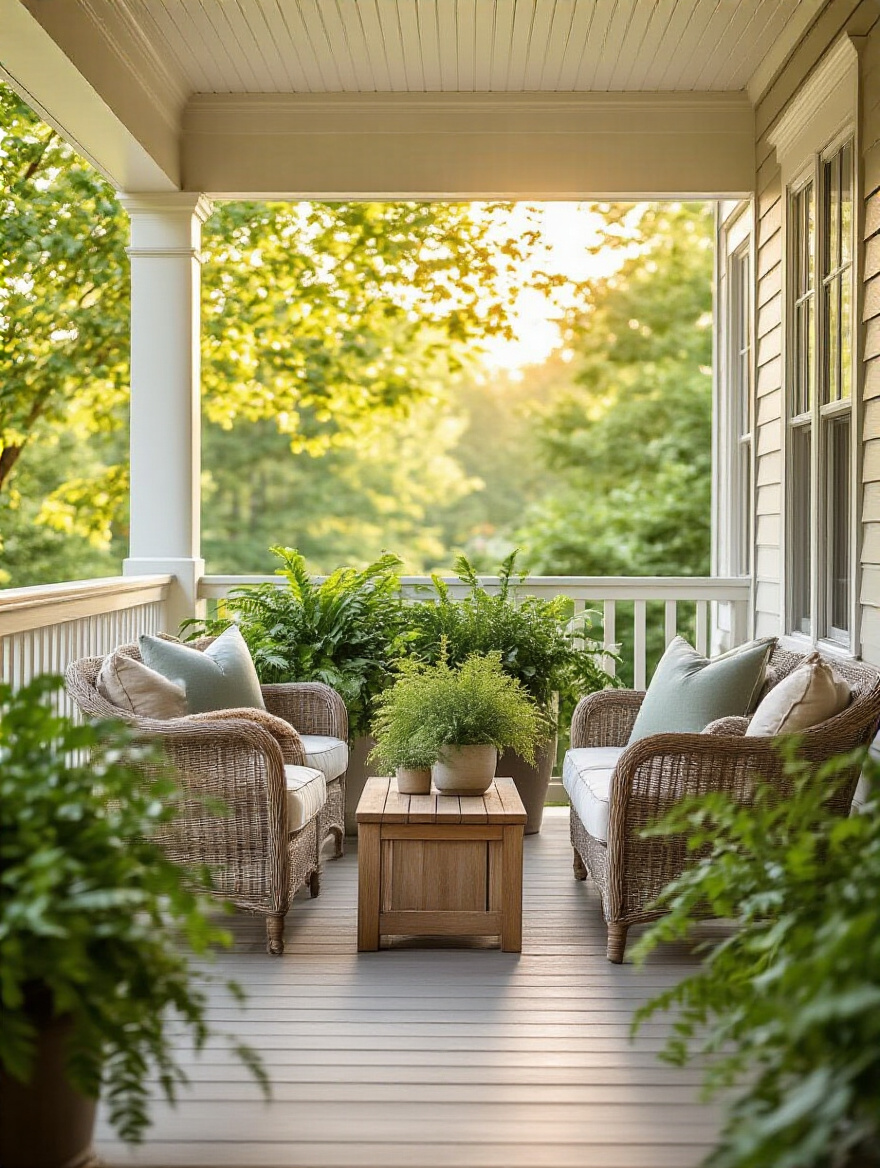
A small, ceramic garden stool is a fantastic, versatile option. It adds a pop of color or texture, can be used as a seat in a pinch, and withstands any weather. For a more traditional look, a small wrought iron or teak table is a timeless choice. On my own 1920s Colonial, I have a simple, sturdy metal table between two rocking chairs. It’s not flashy, but it makes the space a hundred times more functional, which means we use it far more often.
Side tables provide a surface, but what you put on them—or on the walls around them—is where you can inject a truly personal touch.
13. Personalize Your Space with Monograms or Custom Signs
I know I said to avoid generic signs, and I stand by that. But a custom, high-quality sign is a completely different animal. This is about creating something unique to your family and your home. It’s not a trend; it’s a statement of identity. Think less about catchy phrases and more about classic elegance. A beautifully carved wooden sign with your house number spelled out, or a subtle bronze plaque with your family name, can add a touch of bespoke charm.
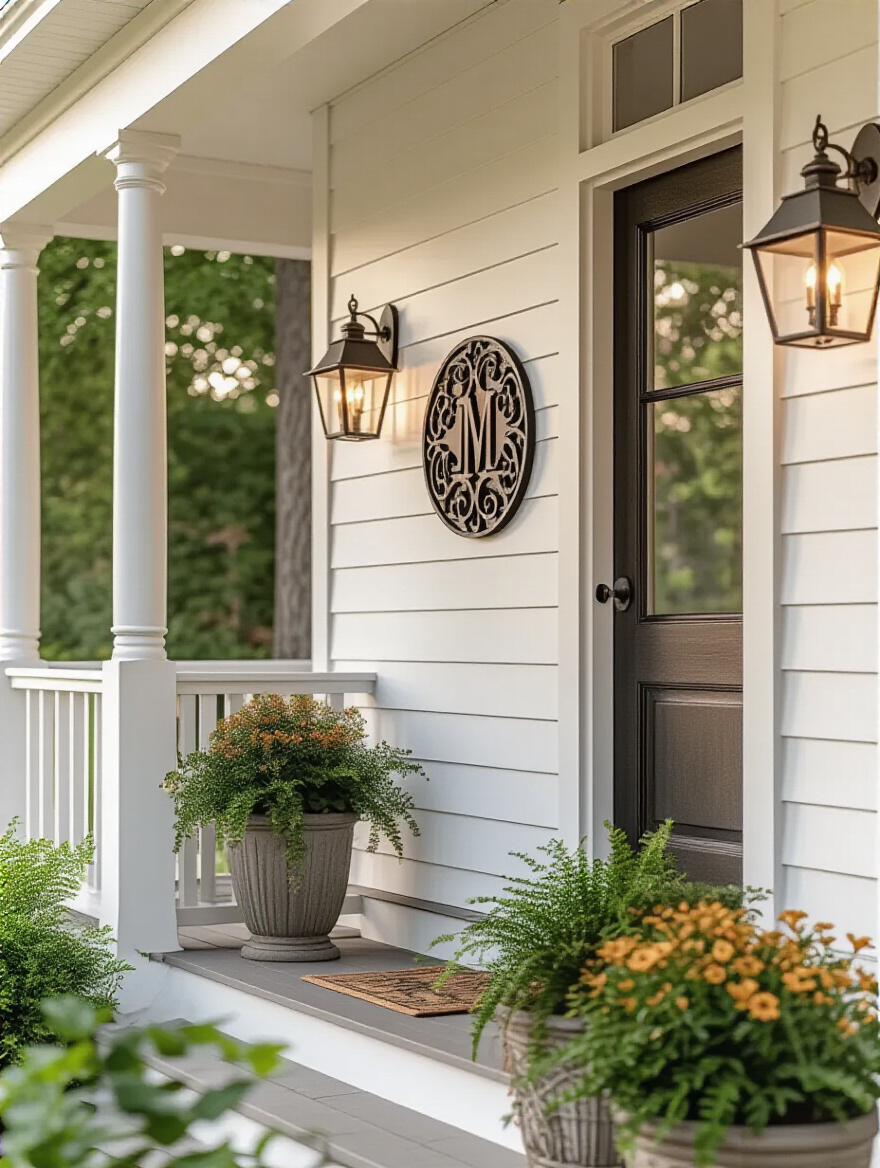
The key is quality and subtlety. This piece should feel as permanent and well-crafted as the house itself. I once had clients commission a local ceramicist to create a custom address plaque in the Arts and Crafts style for their bungalow. It was a small detail, but it elevated the entire entry and became a focal point that they get compliments on constantly. This is an investment in your home’s story, a mark you’re making for future generations.
These personalized elements can be stand-alone, but they often work best when they’re part of a larger, thoughtfully arranged collection.
14. Layer Textures and Materials for Visual Depth
This is a trick that professional designers use to make a space feel rich and sophisticated without being cluttered. Think about all the different materials on your porch: the painted wood of the floor, the smooth ceramic of a planter, the rough texture of a coir mat, the chunky knit of a throw blanket, the cool metal of a lantern. Intentionally mixing these textures creates visual interest and depth.
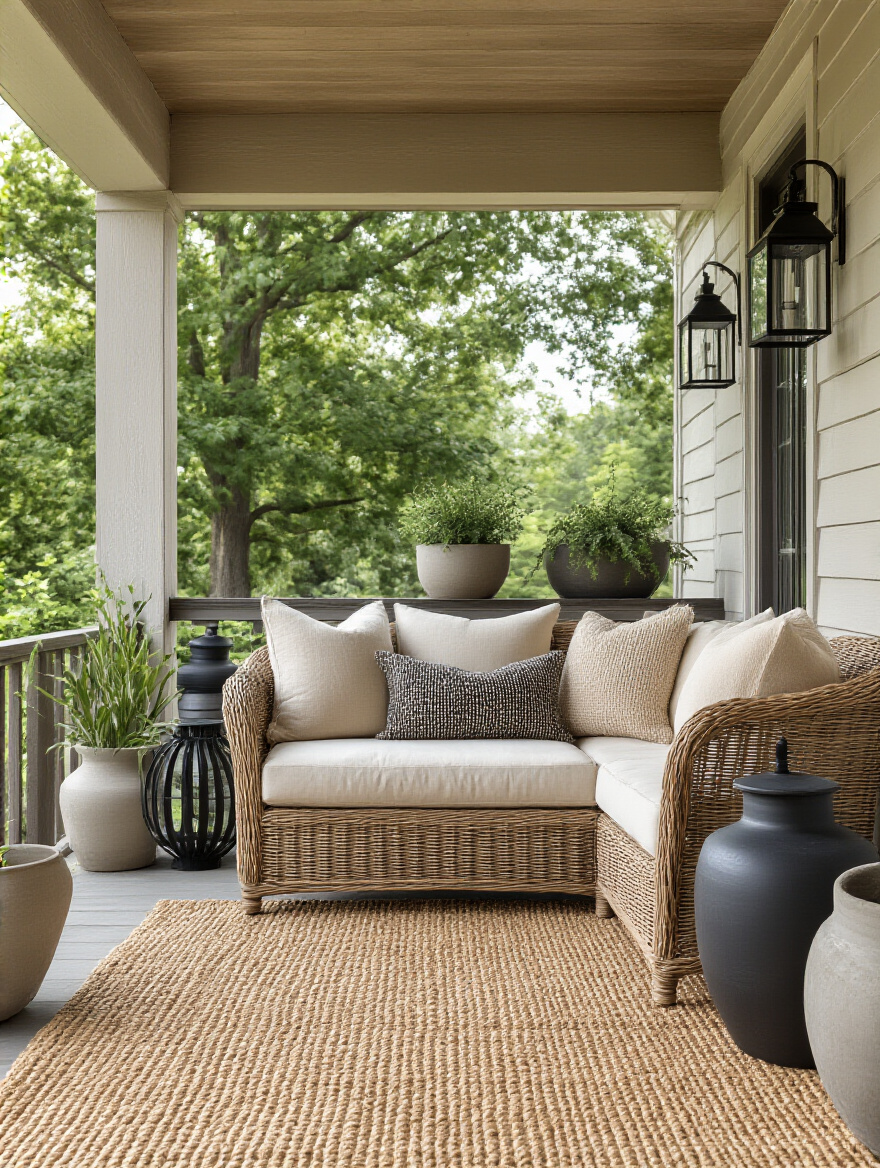
If everything is smooth and uniform, a space feels flat and sterile. If everything is rough, it can feel chaotic. The magic is in the contrast. I encourage clients to think about a “texture palette” just as they would a color palette. For example, on a simple painted porch, you could have a smooth metal side table, a rough terracotta pot, a woven wicker chair, and a soft fabric cushion. It’s this combination of different tactile surfaces that makes a space feel layered, complex, and incredibly inviting.
With all these wonderful pieces, it’s easy to forget that the seasons change, which brings us to a crucial, forward-thinking strategy.
15. Prepare for Seasonal and Holiday Decor Transitions
The best porches evolve with the seasons. A porch that looks the same in October as it does in July feels static and lifeless. But this doesn’t mean you need to buy an avalanche of new decor four times a year. The secret is to build a timeless, neutral foundation with your furniture and major planters, and then layer in small, easily swappable seasonal accents.
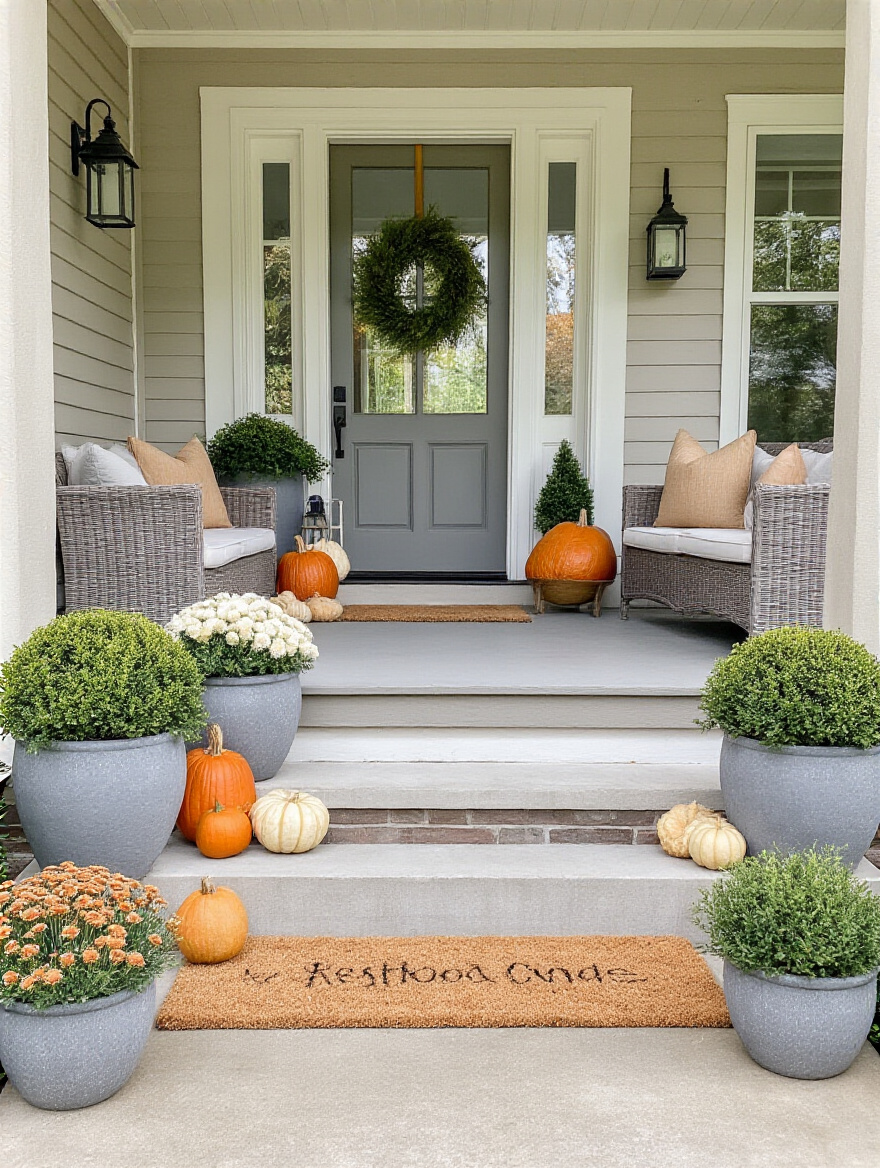
Create a “decor capsule” for each season. In the fall, it might be a simple swap: exchange the ferns for mums, add a wool throw blanket instead of a cotton one, and place a few pumpkins on the steps. For the holidays, it could be adding a natural evergreen wreath and some simple white lights. The key is planning ahead and having organized, well-labeled storage bins for your off-season items. This approach keeps your porch fresh and relevant without the stress and expense of a complete overhaul every few months.
This planned approach allows you to seamlessly integrate decorative objects, which we’ll group into beautiful little scenes next.
Elevating Your Porch with Decorative Accents (Part 2)
We’ve collected our materials, textures, and seasonal accents. Now comes the final, artful act of arrangement. It’s one thing to have nice objects; it’s another to combine them in a way that creates a moment of beauty and tells a story. This is about moving beyond individual items and thinking like a curator for your home’s grand entrance.
16. Arrange Thoughtful Vignettes with Decorative Objects
A vignette is simply a small, curated grouping of objects that creates a focal point. Instead of scattering items randomly, you group them intentionally. A classic designer’s trick is the “Rule of Three”—grouping objects in odd numbers is almost always more visually pleasing than even numbers. And remember to vary the height and texture of the objects within your group.
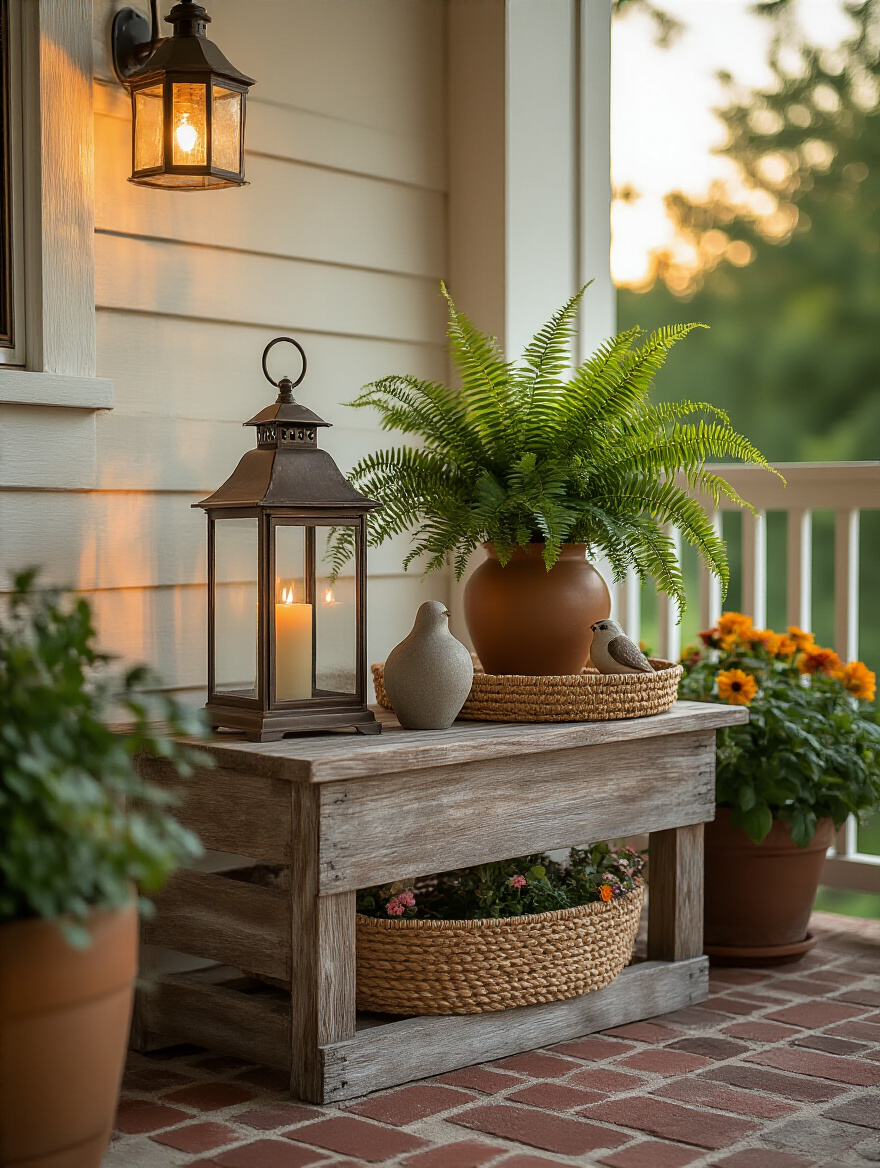
For example, on a small side table, you could create a simple vignette with a medium-height lantern, a small potted succulent, and a couple of interesting rocks or a small decorative object. By a front door, you could group a tall planter, a medium-sized watering can, and a short stool. These little “still life” arrangements are what make a space feel styled and intentional rather than just furnished. They provide little moments of beauty for the eye to rest on.
Now that your porch is a masterpiece, the final and most important job is to ensure it stays that way for the long haul.
Maintaining Charm and Longevity
All of this work is for naught if it’s left to the mercy of the elements without a plan. Preserving the beauty of your historic porch is an ongoing act of stewardship. A thoughtfully designed porch that is allowed to decay sends a worse message than a simple one that is impeccably maintained. This final section is about protecting your investment of time, money, and care.
17. Choose Weather-Resistant Materials for Lasting Appeal
I’ve mentioned this before, but it is so critical it deserves its own place on the list. The number one cause of a beautiful porch turning into a shabby one is the failure of its materials. Do not be seduced by a cheap price tag on an item not explicitly designed for long-term outdoor exposure. It is throwing money away. Your porch is a battleground against UV rays, moisture, and temperature swings. You must arm it with the right materials.
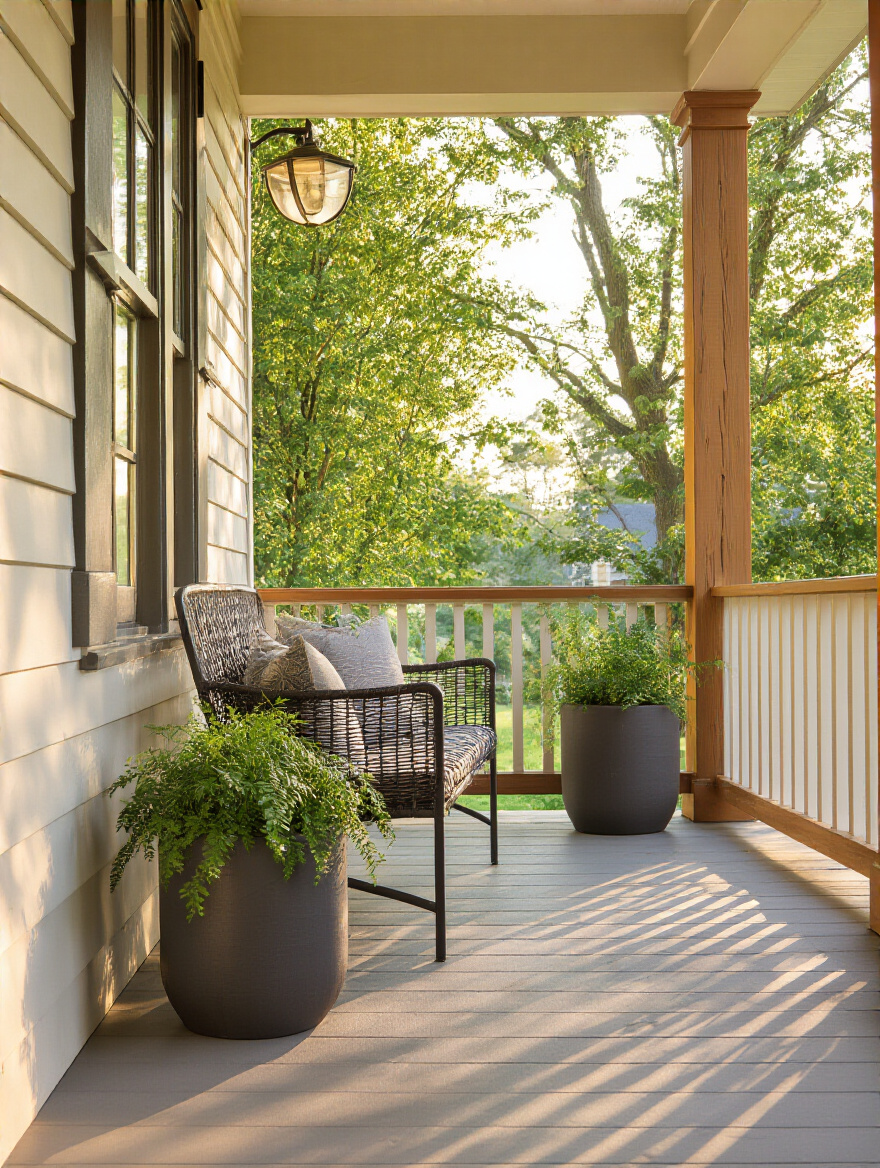
Before buying anything, ask yourself: “What will this look like after two years of sun and rain?” If the answer is “faded, cracked, or rusted,” don’t buy it. Look for words like marine-grade polymer, solution-dyed acrylic, powder-coated aluminum, teak, and composite. This isn’t just about saving money in the long run; it’s about respecting your home. A deteriorating, weather-beaten porch cheapens the entire facade of an otherwise stately historic home.
Even the most durable materials, however, require a helping hand to look their best year after year.
18. Implement a Consistent Cleaning and Maintenance Schedule
You wouldn’t let dirt and grime build up inside your home, and your porch should be no different. It is, after all, an outdoor room. A simple routine is all it takes. Once a week, do a quick sweep to get rid of leaves, pollen, and cobwebs. Once a season, do a more thorough cleaning—wipe down furniture, scrub the floor, and clean your light fixture glass.
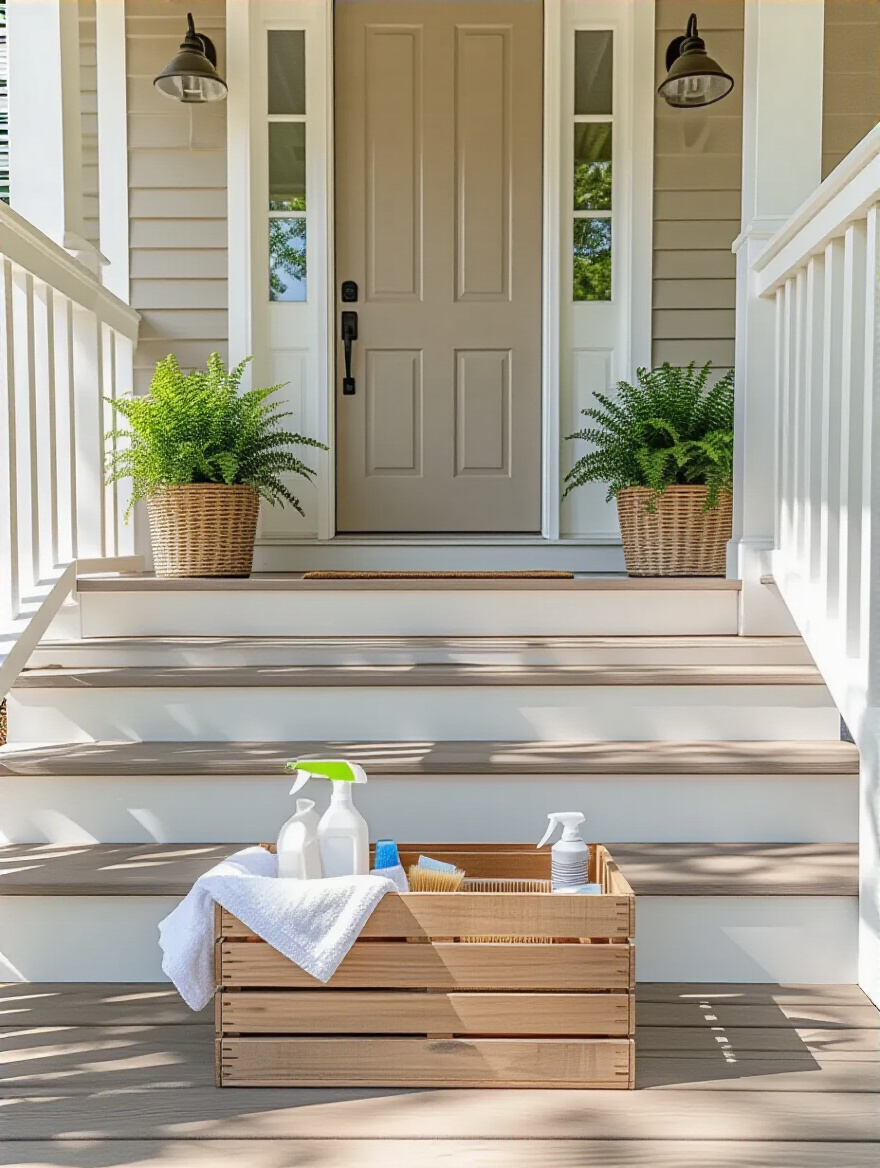
This isn’t just about aesthetics; it’s about preservation. Regular cleaning prevents the buildup of mold and mildew, which can permanently stain surfaces and even cause wood to rot. During your seasonal clean, inspect everything. Look for peeling paint, loose railings, or wobbly furniture. Catching these small problems early prevents them from becoming large, expensive ones. A clean, well-maintained porch signals to everyone that this home is loved and cared for.
As part of your maintenance, don’t forget to look up and take advantage of all the space available to you.
19. Maximize Vertical Space with Hanging Elements
When you’re working with a smaller porch, or even a large one where you don’t want to clutter the floor, going vertical is a brilliant solution. Hanging elements draw the eye upward, making the space feel larger and more dynamic. This is one of the easiest ways to add a “wow” factor with minimal footprint.
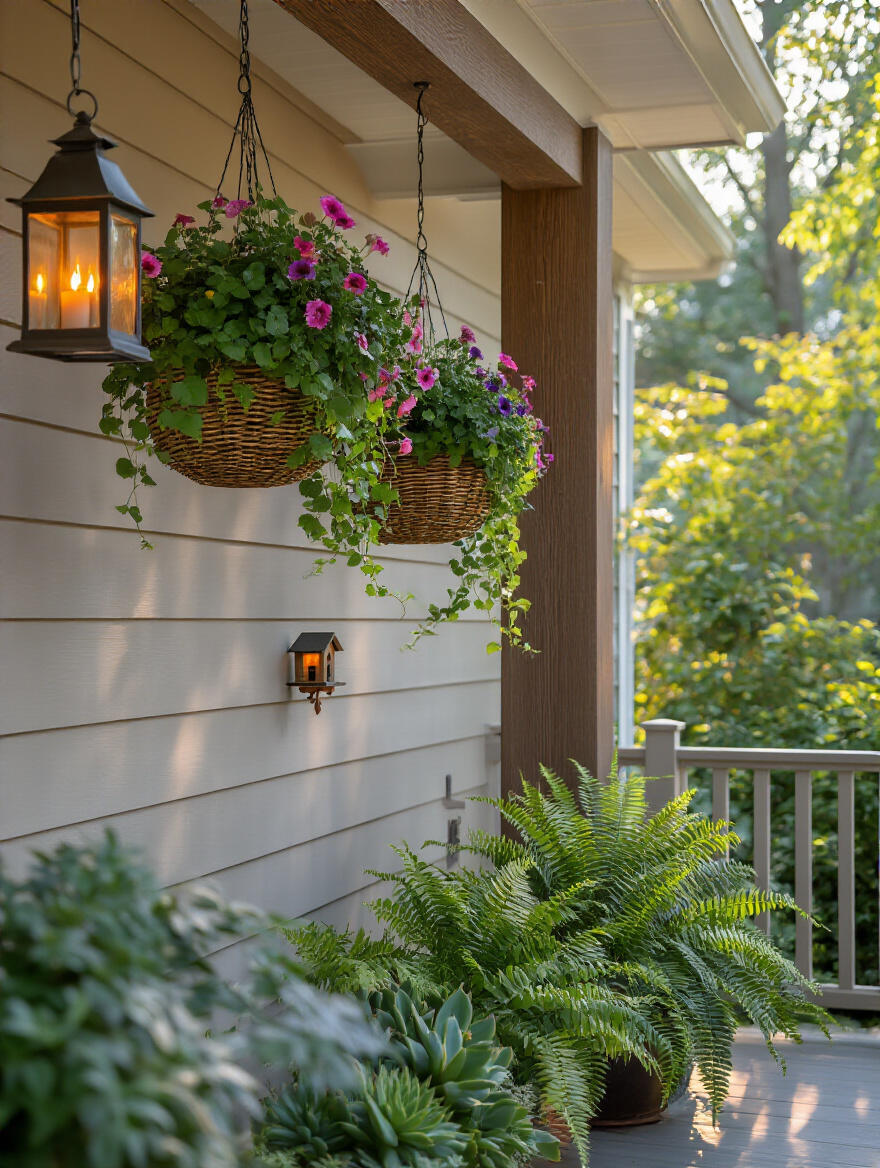
Classic hanging ferns are a beautiful, traditional choice that add lushness and movement. For a sturdier option, consider hanging lanterns (you can use battery-powered candles for a safe, worry-free glow). Wind chimes can add a lovely auditory element. Just be sure to securely fasten any hooks into the structural joists of your porch ceiling, not just the beadboard or drywall. A falling planter is a serious safety hazard.
By drawing the eye upward and maintaining the ground below, you’re setting the stage for a cohesive and uncluttered final picture.
20. Avoid Common Pitfalls: Overcrowding and Mismatched Decor
We end where we began. After all this planning, the greatest danger is enthusiasm—the urge to add just one more thing. Step back. The most common mistakes are overcrowding the space with too much stuff and mixing styles that clash with the home’s architecture. A front porch should be an exhale, not a cacophony.
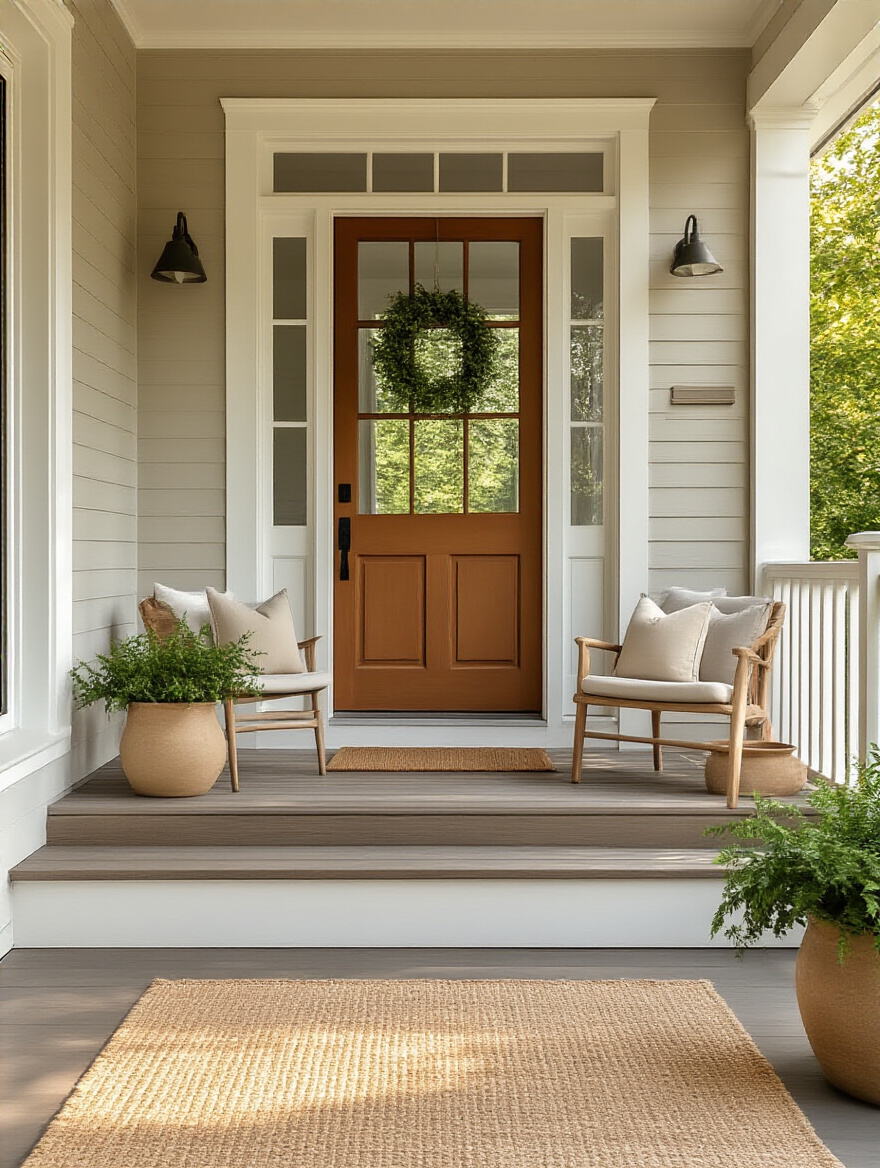
“A design is finished not when there is nothing left to add, but when there is nothing left to take away.” – Antoine de Saint-Exupéry
This is the guiding principle for a historic porch. Curate, don’t accumulate. If you followed the steps of letting the house’s architecture be your guide, you’ve already won half the battle. Now, trust that a few well-chosen, high-quality, appropriately-scaled pieces will always be more impactful than a dozen mismatched, trendy ones. When in doubt, take something away. Give your pieces—and your guests—room to breathe.
Conclusion
There you have it. Decorating your historic home’s front porch isn’t about following a checklist of trends; it’s about entering into a conversation with the past. It’s an act of preservation and personalization. By understanding your home’s unique architectural voice, choosing materials with integrity, and arranging them with care, you do more than just boost curb appeal. You become a steward of its story, honoring the craftsmanship of those who came before you while making the space your own.
Your porch is the handshake your home offers the world. Let it be a firm, warm, and authentic one. Start with one thing—a beautiful light fixture, a pair of classic planters—and build from there. Let your home guide you. Soon, you won’t just have a beautifully decorated porch; you’ll have an outdoor sanctuary that feels like it has always been there, patiently waiting for you to come and sit for a while.
